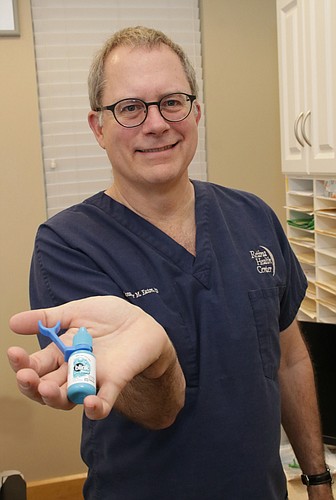- December 13, 2025
-
-
Loading

Loading

In a corner office on the second floor of Dr. Alexander Eaton’s Retina Health Center in Fort Myers is a laboratory, but not the kind you might expect.
It’s a lab that has produced 13 U.S. and 22 foreign patents held by Eaton and colleagues, as well as their latest invention, XactDrop. He shares patents with Gabriel Gordon, Guangjun Gao, Ruixue Liu and Brian Bradley. XactDrop is an eye drop applicator device designed to help patients more accurately deliver eye drops. The invention is also a continuation of Eaton's ongoing mission to find a better way for people to dispense eye medication. Along the way, Eaton is learning some key business lessons, including how to match projected revenue with real expenses and coming out on the profit side.
As the first over-the-counter product developed by the practice, for example, Eaton wants to make XactDrop available in retail outlets. Eaton declined to disclose his production costs for the product, which is made in China. His marketing challenge? That lies in inexpensively promoting the product to match his desire to keep it priced affordably.
“Our initial strategy is to create awareness through ophthalmic literature and journals, and most likely through education of physicians and at trade shows as well as a discussion of the issues in the media because the magnitude of the problem is significant,” says Eaton. “One of the issues for us in terms of marketing is we sell it very reasonably. It's a multi-use product, and it’s incredibly cost-effective for patients. But to keep it cost-effective doesn’t provide us with revenue for large marketing campaigns. We're just getting started on that journey, and we’re going to learn about it as time goes by.”
“When you look at the cost of eye drops today, it can range from a few dollars to hundreds of dollars, and successfully getting the eyedrop in can save patients considerable amount in medication costs." Dr. Alexander Eaton
Inaccurate delivery of eye drops may not seem like a big problem, but it is one Eaton defines as epidemic — and a big business opportunity. His practice’s own in-house research on patients found only 9% who use therapeutic eye drops can correctly self-administer them. Notably, more than 80% of patients touched their eye or eyelashes with the tip of the eye dropper, and many missed their eye without realizing it.
“It's a significant problem for some people,” says Eaton, who founded the practice in 2002 with offices in Fort Myers and Naples.
Getting 100% of the drop in the eye, Eaton says, isn’t necessary for therapeutic benefits. At least half the drop, though, is critical, and Eaton says it is often difficult for patients to determine if an adequate amount of medication reached its target. Nearly as problematic? Using too many drops in effort to get enough in the eye, wasting sometimes expensive drops.
“When you look at the cost of eye drops today, it can range from a few dollars to hundreds of dollars, and successfully getting the eye drop in can save patients considerable amount in medication costs,” says Eaton.
Correct application of drops is particularly difficult for elderly patients, those with tremors or whose condition impairs their vision.
The solution, Eaton believes, is his patented plastic device that attaches to the eye drop bottle on one end with a curvature on the other that allows it to be braced on the bridge of the nose, stabilizing the bottle in the optimum position. It is available in Eaton’s offices or XactDrop.com. Priced at $8.99, it includes two sizes of the XactDrop device.
Although simple in appearance, XactDrop is the result of four years of research, which began as a quest to devise a method of scanning patients’ ability to accurately self-dose. Several generations and years of testing yielded a USB-compatible device with a built-in camera that allows his staff to view the video and train patients to correctly dose. From that design, XactDrop was developed.
“We started by imaging them,” says Eaton. “Then we used that data learn more about it and then to move on to delivery device.”
Total research and development costs are difficult to calculate, Eaton says, because much of it was done inside the office by staff and interns. He can only call those costs “significant.”
The heart of Eaton's R&D lab is in a corner of the office — a 3D printer that's generated dozens of versions of XactDrop, all stored in a small box he calls “the graveyard of designs past.”
Not yet available for market — but more proof of Eaton's devotion to the mission — is a companion product designed for single-use eye drop packaging.
Also, the patented video recording device that started it all is not yet in production, but Eaton envisions it as a clinical tool for in-clinic use or loaned to patients. “It’s the first system that can video people at home and has led to a better understanding of drop delivery, compliance and, subsequently," adds Eaton, "to our simple device."